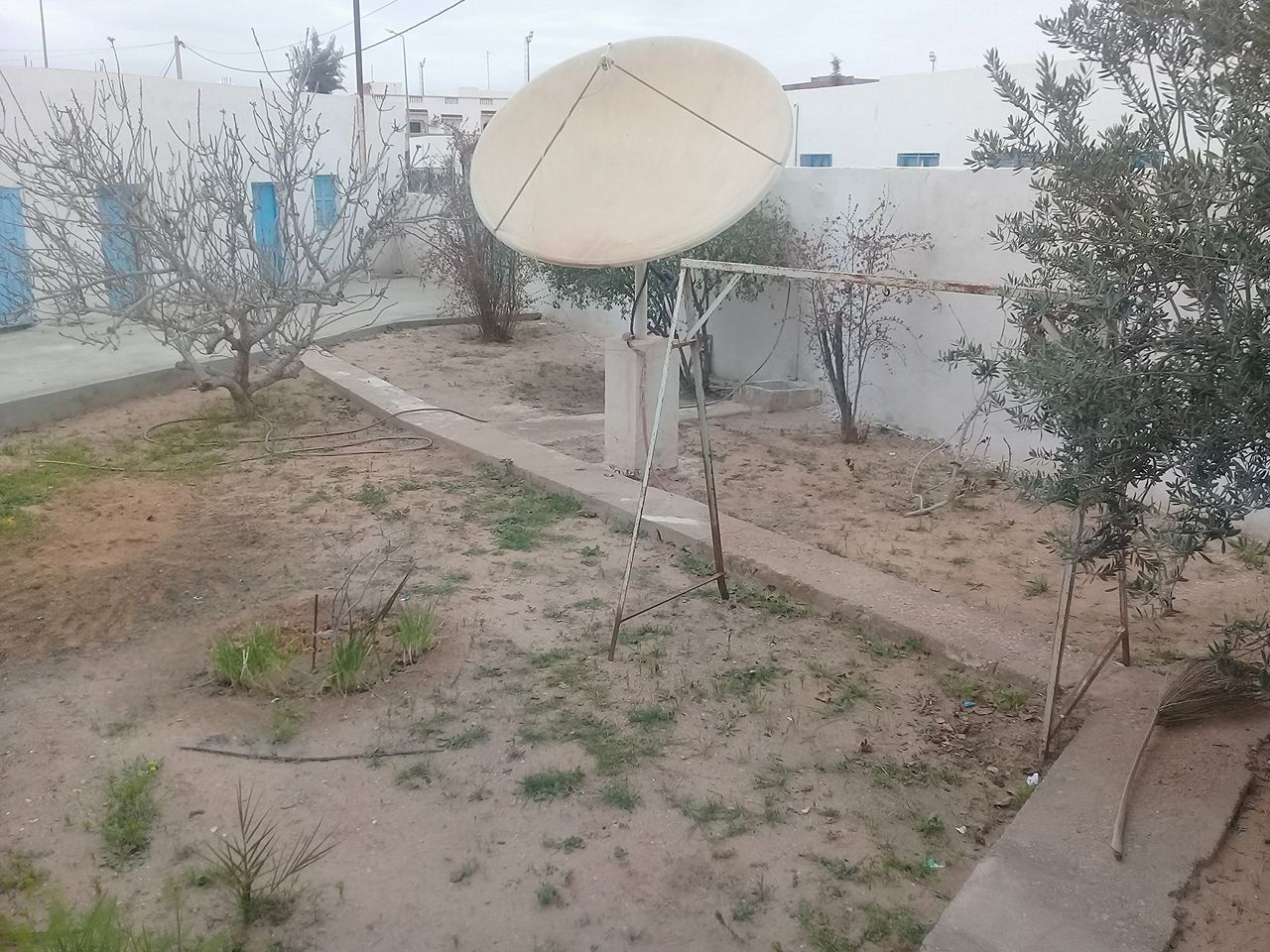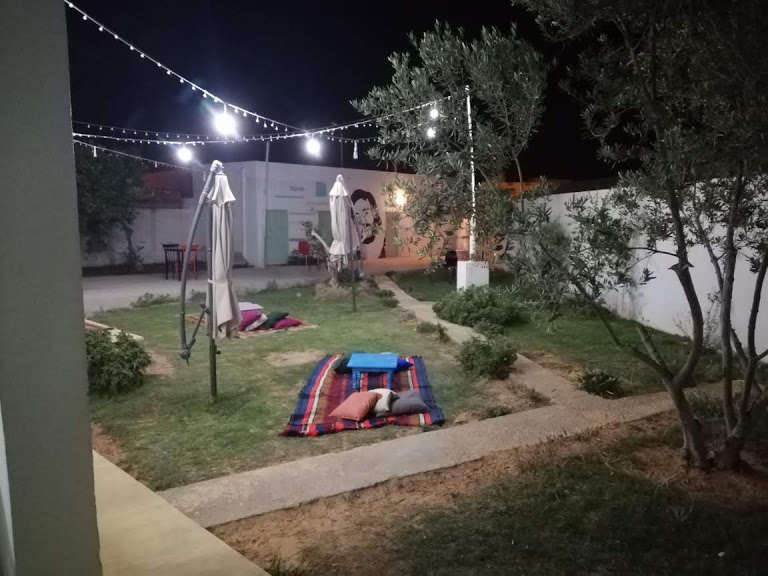1. Problem context
How could plants in deserts grow without human intervention? The basic insight is that it does rain in most deserts. Just very erratically – there could be one big rainstorm in 5 or 10 years. So the problem for plants is not so much the absence of rain, but how to store the water until the next rain. Because there is no soil that could store the water naturally, and the water storage capacity of soil is too limited anyway to store water for multiple seasons. It is also not practical to bring in that much soil (2-5 m depth maybe?) and even if that would be done, the dry topsoil would quickly be carried away by wind erosion.
2. Basic idea
The following is a new technique to create maintenance-free, resilient forests (or at least groups of trees) right in the desert. It is based on the same principle as the “sub-irrigation planter” or “self-watering pot with wick” designs (example DIY design), but adapted to the water needs of trees and to a potential for 10-year draughts. The basic design choice for a setup that never needs further human intervention is that we need a way of water storage where the water table does not vary much, but to compensate, the stored water will cover a larger surface area. The reason is that water can be extracted using capillary action (of soil, roots, or artificial fibers) if and only if the water table depth does not vary much. Capillary action is a completely maintenance free technique that can last for hundreds of years, very much unlike pumps, and also unlike setups where water under pressure slowly drops on plants (as in drip irrigation). Dirt and dissolved minerals in dripping water can plug the essential dripping holes, which would then require human intervention.
3. Design proposal: with tunnels
Capillary action can raise water by one or a few meters, depending on the fineness of the capillaries. So a 20 m deep hole in the ground is not suitable, obviously. However, a 2 m high, waterproofed tunnel drilled horizontally or with a <0.5% upwards slope into the hillside is suitable. Instead of one tunnel, it is also possible to make it branch off internally, increasing the storage area by a lot. Water from these tunnels would flow out of the tunnel into narrow canals, also at about 2 m water depth. The trees and other plants would be planted right on top of the canals, with the roots embedded in soil above the water level, receiving water only through capillary action. This is because roots below the water table will quickly rot, killing the plant.
Now to move the water from the canals vertically upwards through the soil to the tree roots, various mechanism can be used:
-
Filling the canals (but not the whole tunnels of course) completely with soil, which then mimics groundwater; to prevent water loss, it is still important that the canals are watertight on all sides.
-
Wicks made from cotton or polyester fiber that hang vertically into the water-filled canals. Compared to soil, this has the advantage that the water access of the trees can be better regulated. For example, the wicks can be designed so that with decreasing water level, the water supplied to the trees also decreases in order to prevent running out of water. In addition, the sizing of the wicks would be adapted to the type and size of the tree. They should not supply too much water, as that instructs the tree to conserve water by growing thicker and more waxy leaves, which is obviously better for a desert location.
-
Porous bricks or other porous clay objects, as an alternative and perhaps more durable material to wicks made from fiber.
Now for the tunnels to be filled during rainfalls, one would drill vertical or steeply sloped access holes, starting in natural drainage channels / rivulets and ending in the tunnel. They should be small in diameter (max. 20 cm) to prevent too much water from evaporating over the years, and can also incorporate a valve / flap mechanism to further prevent evaporation. And of course, there must be proper mechanisms to prevent animals (or even children) from falling into these holes.
In total, this mechanism can catch whatever rain falls on a higher ground, and will distribute it slowly over the next year(s) to plants on somewhat lower ground, such as the side of the hill. While soil (esp. hard sun-baked soil) has a limited rate of letting water seep in, the drainage shafts and tunnels can store water very fast in a downpour and will not waste any water when it is available.
4. Design proposal: with covered ponds
This is quite similar to the design proposal with tunnels, but requires no tunneling or drilling – only digging. This seems much more appropriate, as it will be much cheaper.
Instead of tunnels, it would use artificial ponds, with a plastic liner at the bottom, running horizontally along a hillside or at the bottom of the hill. If built along the hillside, it can be built on a terrace, in a format such as 30 × 3 m. This allows to have groups of trees at several heights on the hillside. And instead of the vertical holes for water inflow, existing rivulets or gullies from the hillside can be redirected to flow into the pond. However, a way has to be found to deal with sediment buildup, for example using a settlement pond or a cyclone-type fluid filter.
All ponds have to be covered, to prevent evaporation during the potentially multiple years of water storage. If it is wider than about 3 meters, the covering would rest on pillars built in a grid fashion in the pond. Plants are then placed right on this covering, with enough soil – and that soil might have to be covered with slate sheets to prevent wind erosion. The soil is kept moist with wick-type fabric items hanging into the water below.
5. Design improvements
Waterproof catchment areas. These designs can be combined with covering hillsides in slate or cut natural stone slices, heavy enough to not be moved by wind. They would require to be cut in a special shape so that they overlap and interlock, not sliding down into the valley by their weight. For example, slabs of 40×40×5 cm that are laid with one corner pointing into the valley and have cutouts along their lower edges so that they overlap and interlock with the row of slabs below. Like on slate roofing, water will flow downhill into the pond without ever touching the ground, that is, without seeping into the ground. This way, even light rainfalls contribute to refilling the pond. This is very similar to the ancient Tunisian water harvesting technique of the jessr, but improves on it by changing the “annual average runoff coefficient” of the hillside catchment area. It was 0.153 in Amrich near Beni Kheddeche, measured between 199 and 2001 (source). This means, 15.3% of the water was runoff water and could be catched by the jessr terrace farm, while 84.7% of the water was seeping into the ground and “lost” because non-concentrated rainfall is not enough for agriculture around Beni Kheddeche. With covered hillsides, the lost 84.7% of the water can also be covered, which means that about 84.7% / 15.3% = 5.9 times more growing area can be used in the Beni Kheddeche area.
White hillsides. Now while we are already up for covering the hillsides with waterproof material, let’s use white or bright material. When applied in a large enough area, it will bring down the average outdoor temperature by several degree Celsius. For example, the white polytunnel greenhouses around Almeria, Spain, decreased the temperature in the area by 3 °C, and that in spite of global warming. Of course, the question is how to make this also aesthetically pleasing and safe for wildlife. So we better want to use slices of white natural stone and not plastic. If white stone slabs are not available locally, the dark stone can be painted with lime or other natural white pigments. Alternatively, the stone slabs (whether white or dark) can be covered, as there is no need to expose the stone slabs directly. So for better aesthetics, they can be covered with white gravel or white stones of various sizes, giving the place a more natural look. The only requirement is that the cover material does not soak up much water when it rains, and also does not leak many sediment particles when it rains. Terraces with trees and other plants would be dispersed within these white-covered hills in different heights, making for a beautiful view.
White stone cover for the soil. And while we are at it, let’s also place white stone slabs on the soil around the trees. This helps to keep the ground cool by reflecting sunlight, preventing evaporation. It also helps against wind erosion.
Variable water use. Trees, especially olive trees, take a long time to grow and are very valuable. The hydrology system must ensure their survival with the highest priority. So it will be very conservative with water use and tree numbers to be able to water the trees even through multiple drought years. This also means that in most years, excess water is available and can be used in agriculture for annual plants like wheat, barley etc… In dry years, the annual plants will simply not be planted, waiting until the water storage has filled again to be sure of tree survival first.
Reducing soil evaporation. When planting trees in soil that is moistened by wick action from the proposed reservoirs, the water is not directly exposed to the air, which greatly reduces evaporation. Still, there will be considerable evaporation as the moist soil is exposed to the air. This can be considerably reduced by placing a layer of plastic sheet material or of water-impermeable soil (clay) on top of the root soil, and then some more soil or rather gravel and sand on top of that for protecting that layer. This way, only the planting holes expose moist soil to the air.
 This is an idea that came to me today. I think this is the right principle, but the idea is not yet good enough – because drilling tunnels is too expensive. But we’ll have the right insights one day, and then we’ll plant trees in Beni Khadech together
This is an idea that came to me today. I think this is the right principle, but the idea is not yet good enough – because drilling tunnels is too expensive. But we’ll have the right insights one day, and then we’ll plant trees in Beni Khadech together 


